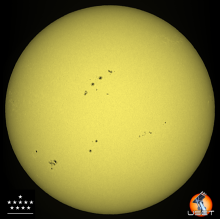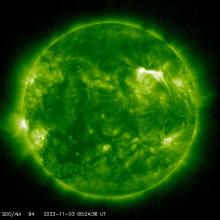While the daily sunspot number skyrocketed last week, the number of strong flares was quite modest.
SIDC News
So far, ongoing solar cycle 25 (SC25) has been geomagnetically more active than its predecessor SC24, but remains overall well below the long-term average of SC17 to 23.
A trio of earth-directed CMEs resulted in a major geomagnetic storm.
You can help her win the prize of the public by casting your vote.
The Locarno station just completed a 5 year digitization project archiving sunspot observations and data from 1 June 1957 onwards.
The EUI and SWAP/LYRA PI teams welcome research proposals for the 2024 round of its Guest Investigator Program for research based on EUI, SWAP or LYRA data.
Don’t forget to come visit our radio antenna's in the coming weekend! It is a unique opportunity to have fun with the whole family in a beautiful environment.
ESA’s Solar Orbiter spacecraft has discovered a multitude of tiny jets of material escaping from the Sun’s outer atmosphere. Each jet lasts for between 20 and 100 seconds, and expels plasma at around 100 km/s. These jets could be the long-sought-after source of the ‘solar wind’.
A joint scientific team led by the Royal Observatory of Belgium (ROB) and the KU Leuven has found that high-frequency magnetic waves could play an essential role in keeping the Sun’s atmosphere at millions of degrees. This finding sheds a new light on the most intriguing solar mystery: what makes the Sun’s atmosphere hotter than its surface?
The SIDC Forecasters at the Royal Observatory of Belgium played a key role in an ESA exercise to define how to communicate clearly on the impacts of extreme space weather events.
Mark your calendars for the weekend of 9 and 10 of September 2023!
An important milestone was achieved mid-June when the mount and parabolic reflector were installed for the Open Access Radio-Telescope project











